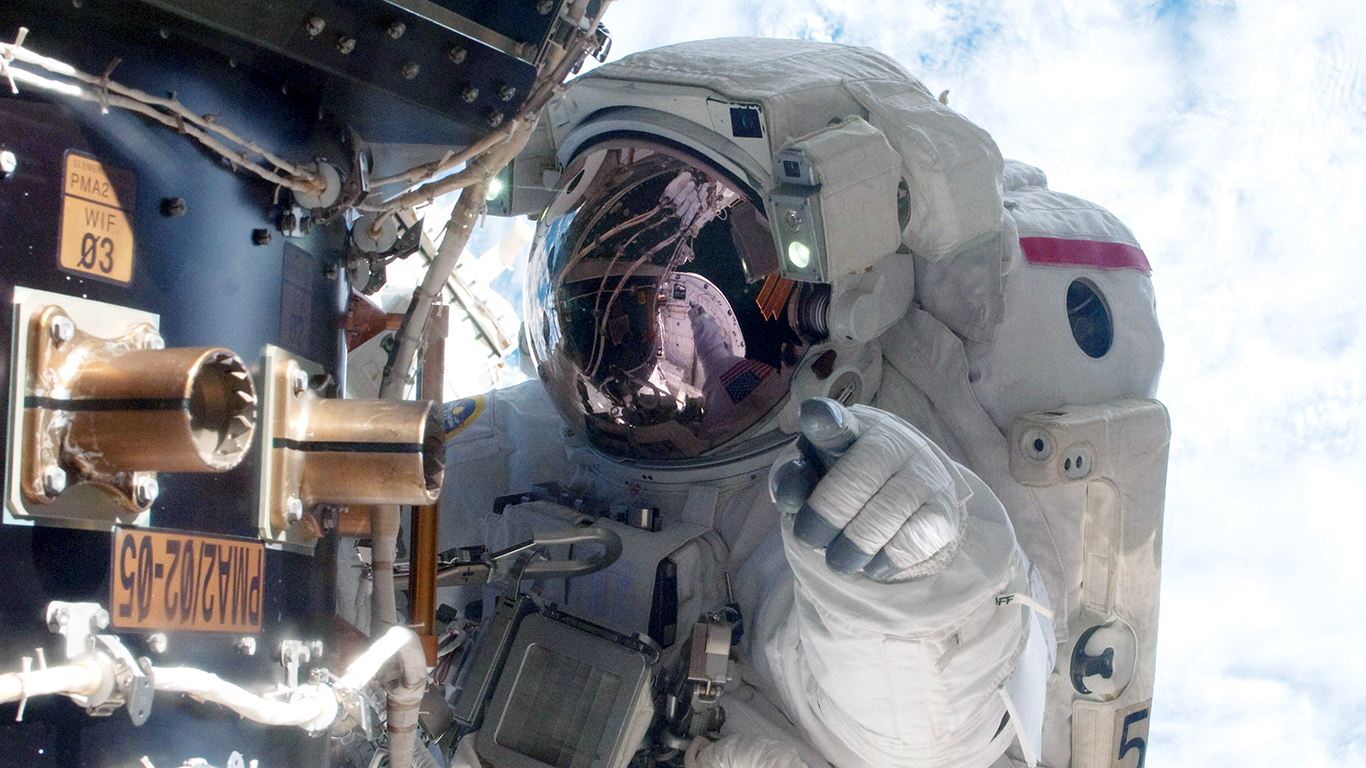
The Cold War was more than a buildup of arms, it was also a space race between the United States and the Soviet Union that began with the launching of Sputnik in 1957 and culminated with “…one giant leap for mankind.”
The U.S.S.R. put the first satellite into orbit, the first man into orbit, the first woman into orbit, and accomplished the first spacewalk — even though the U.S. was always close behind with these achievements.
But when America was able to orbit and land a man on the moon first, the race was effectively over. The story then became became one of cooperation as the U.S. and Soviet Union teamed up for the Apollo-Soyuz Test Project and later at the International Space Station.
To compile this list, 24/7 Tempo reviewed material from the National Aeronautics and Space Administration (NASA), as well as websites such as archives.gov, and phys.org.
The competition for supremacy in space made national heroes of Yuri Gagarin, John Glenn, Valentina Tereshkova, and Neil Armstrong, among many other astronauts and cosmonauts in the 20th century. But it also accelerated technological advances and product developments — these are 30 inventions we use everyday that were actually created for space exploration.
Click here to see the biggest milestones in the Space Race.
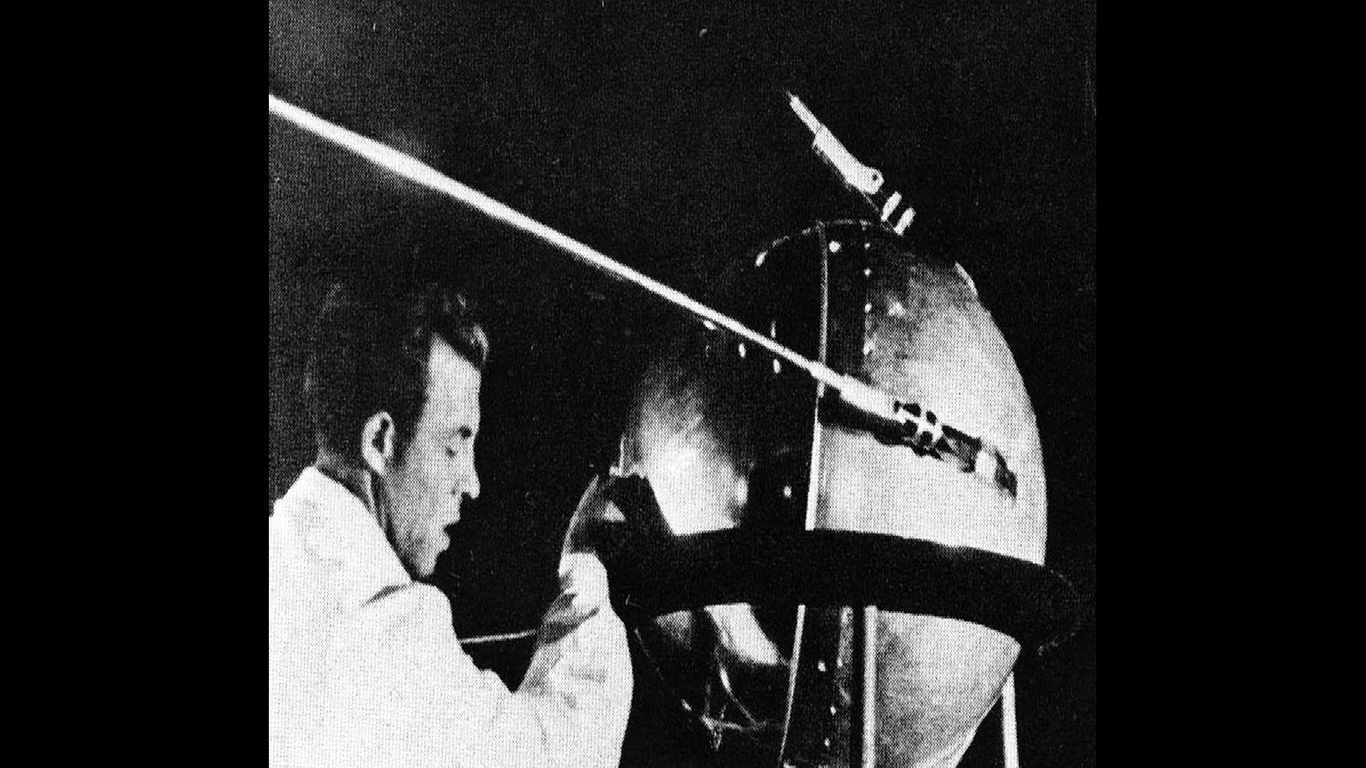
1. October 4, 1957: First artificial satellite
Sputnik I, the world’s first artificial satellite, was launched into space on October 4, 1957. The Soviet Union surprised the U.S. with its achievement, beginning the space age and the space race between the two superpowers. Sputnik, named after the Russian word for “satellite,” circled Earth once every 96 minutes and could be viewed with binoculars before sunrise or after sunset. The satellite orbited the Earth until 1958, when it burned up in the atmosphere.
[in-text-ad]
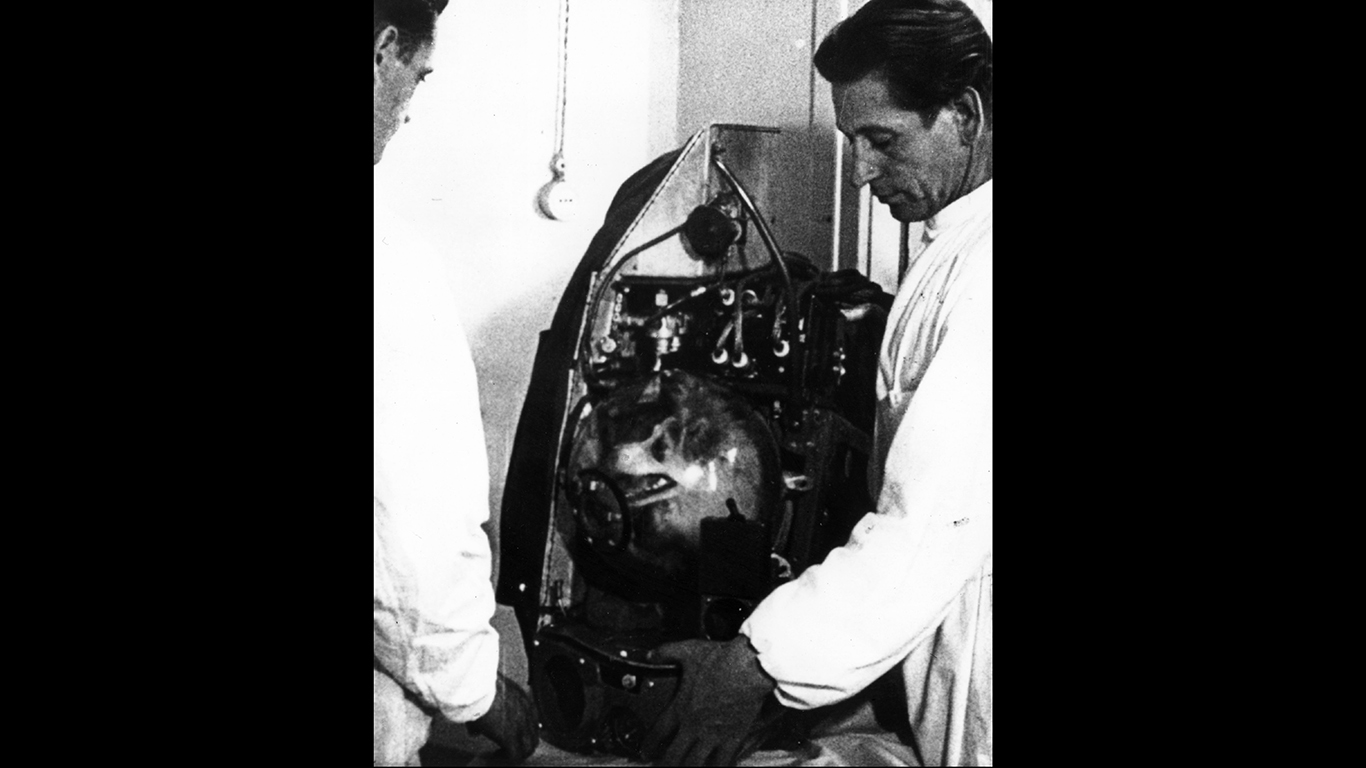
2. November 3, 1957: First living being to orbit Earth
Before there was one giant leap for mankind, animalkind was paving the way for humans in space. Scientists were unsure of the effects of prolonged weightlessness on humans, and wanted to test the possible dangers of space flight on animals first. American and Russian space programs used animals — typically monkeys, chimps, and dogs — to experiment, starting in the late 1940s. These experiments were not always successful, with several of the animals dying in the process. The first animal to be launched into orbit was no exception. On November 3, 1957, the Soviet Union launched Sputnik II with a dog named Laika (“Barker”). A stray dog, who was quickly trained, she died within hours, and without a viable re-entry plan, was never recovered from space.
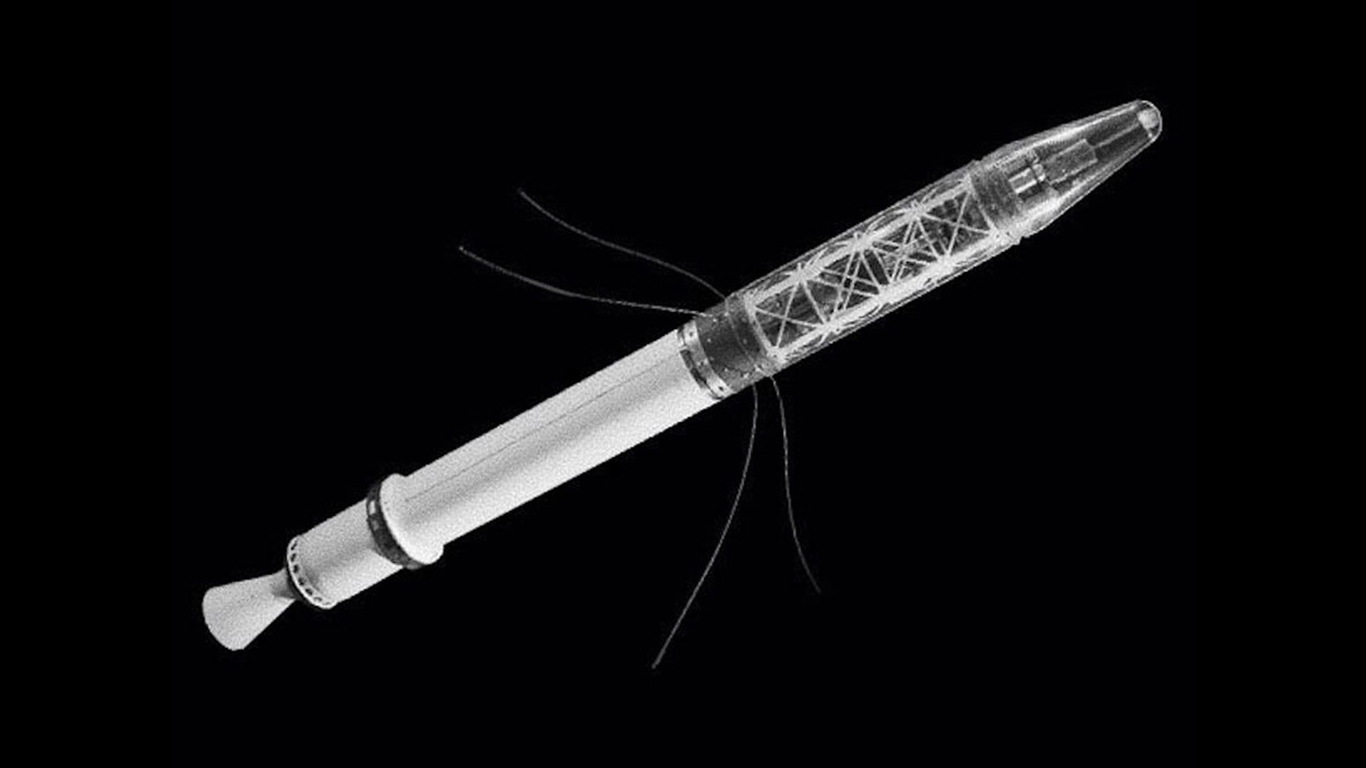
3. January 31, 1958: Explorer 1
Spurred by the Soviet Union’s launch of Sputnik, the U.S. ramped up its own efforts to put a satellite into orbit. The first attempt exploded on national television during the launch. But about two months later, on January 31, 1958, NASA succeeded with Explorer 1, designed by the Jet Propulsion Laboratory. The satellite made one orbit about every 115 minutes, until burning up in Earth’s atmosphere on March 31, 1970. Explorer 1’s main science instrument was a cosmic ray detector that measured the radiation environment in Earth orbit, which revealed a much lower cosmic ray count than previously thought.
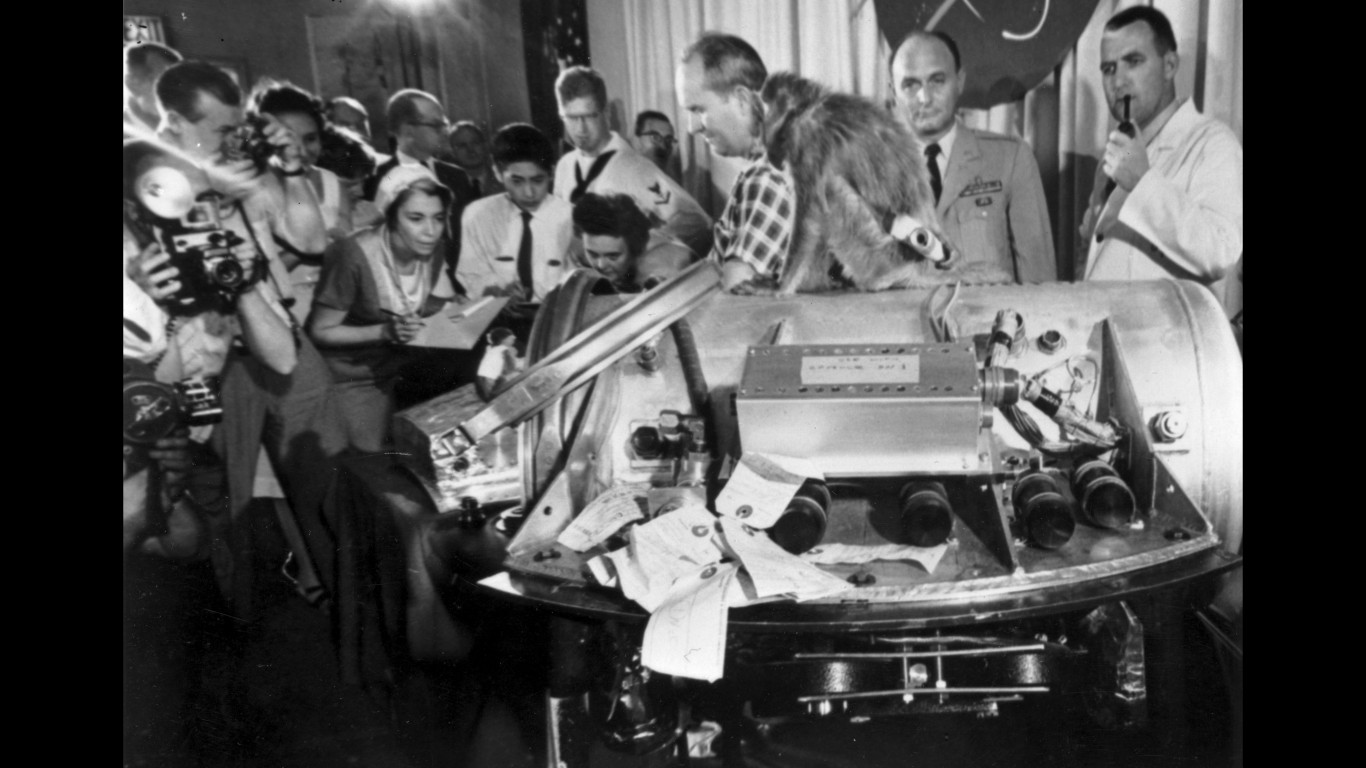
4. May 28, 1959: First primates to successfully return to Earth
A rhesus monkey named Albert I was first launched into space from White Sands, New Mexico on June 11, 1948 to test the effects of long-term weightlessness on humans. Albert died during his flight, and subsequent flights with other test monkeys also failed to recover a subject alive. Finally, on May 28, 1959, a rhesus monkey named Able and a squirrel monkey named Baker reached an altitude of 300 miles and survived the entire journey. Unfortunately, Able died only a few days later from anesthesia complications while doctors were removing an electrode from under her skin. Baker died of kidney failure at age 27 in 1984.
[in-text-ad-2]
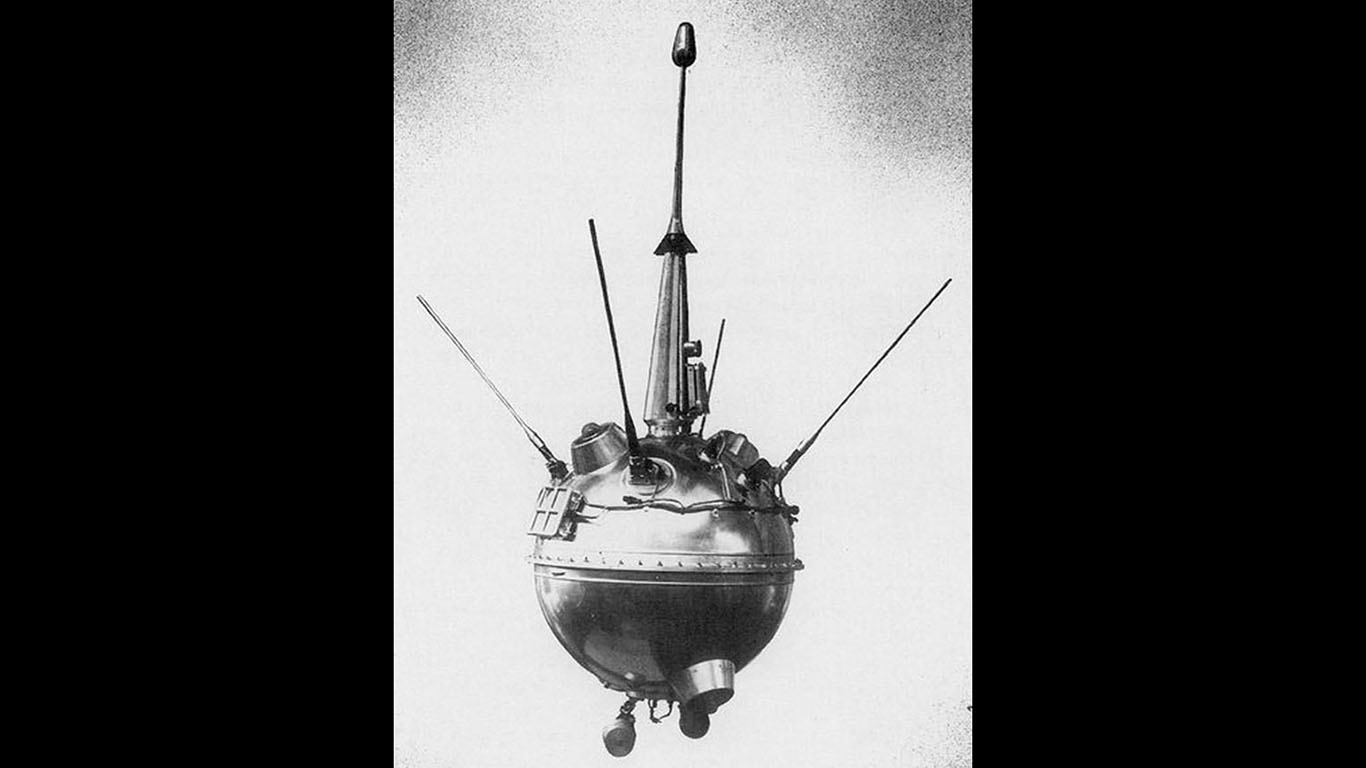
5. September 14, 1959: First man-made object to reach the moon
The Soviet probe Luna 2 crashed onto the surface of the moon on September 14, 1959, becoming the first man-made object to reach it. Part of its mission was also to experiment on the behavior of gas in space, confirm that the moon had no appreciable magnetic field, and look for evidence of radiation belts. Luna 2 was part of a series of unmanned lunar probes launched by the Soviet Union. Luna 1 (January 2, 1959) was the first to escape Earth’s gravity, but failed to reach the moon.
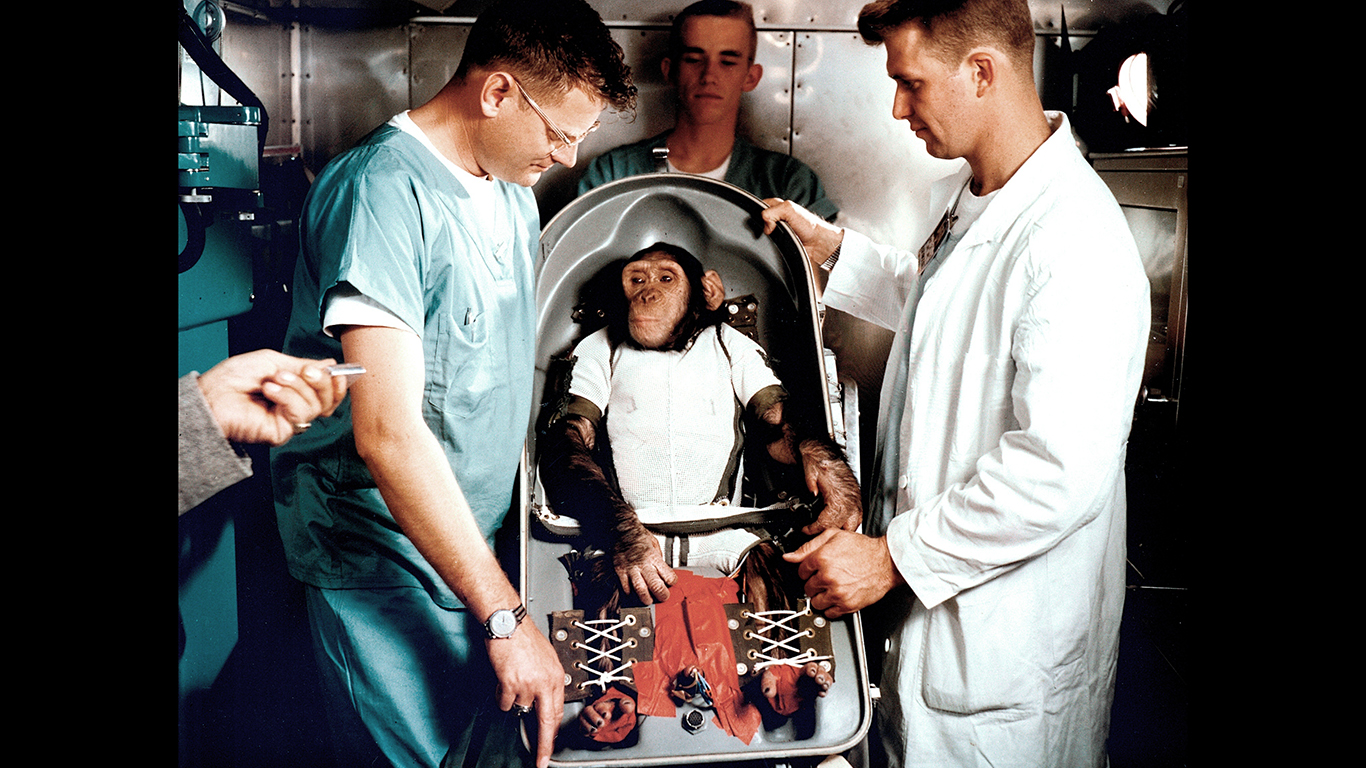
6. January 31, 1961: First chimp in space
Although several animals preceded him in the space program, Ham was the first hominid to be launched into space on January 31, 1961. His mission also helped pave the way for America’s first human astronaut, Alan Shepard. Ham, whose name was an acronym for the Holloman Aerospace Medical Center, where he was trained, performed well during the flight, only suffering from fatigue and mild dehydration. He became a celebrity after the launch, even appearing on the cover of Life magazine. Ham lived the rest of his days at the National Zoo in Washington, D.C, and the North Carolina Zoological Park, where he died at age 26 in 1983.
[in-text-ad]
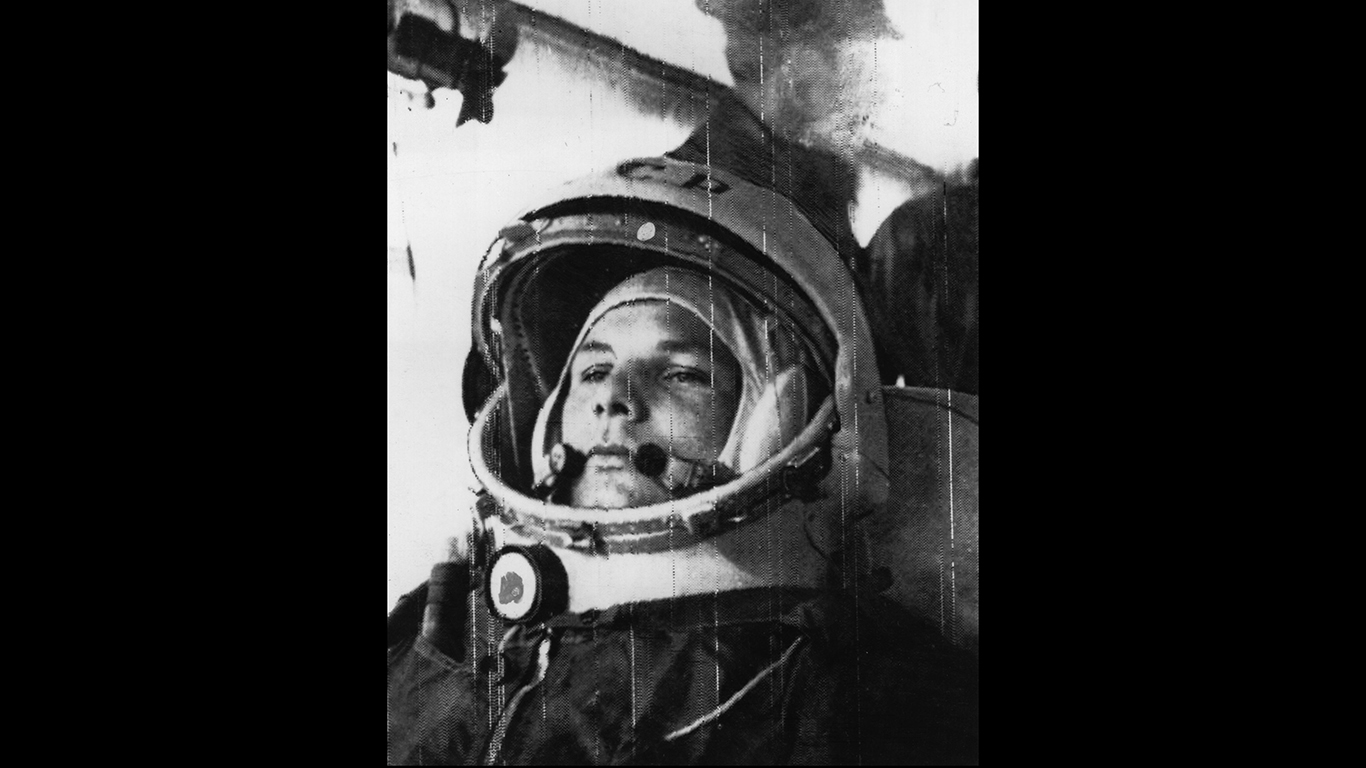
7. April 12, 1961: First man in space
Cosmonaut Yuri Alekseyevich Gagarin became the first human to fly into space on April 12, 1961, once again giving the Soviet Union a win in the space race. Orbiting the Earth aboard the spacecraft Vostok 1, his flight took 108 minutes, reaching an altitude of 187 miles, in just over one orbit. The U.S had planned on launching its first manned space flight the following month, but wouldn’t achieve what Gagarin had, orbiting the Earth, until the following year. Gagarin became an international hero, and at home earned the title of Hero of the Soviet Union, with monuments and museum exhibits still honoring him to this day. The Soviet Union, wary of sending a national hero into space, allowed him to test flights for the air force, but he died on the job in 1968. His remains are interred at the Kremlin.
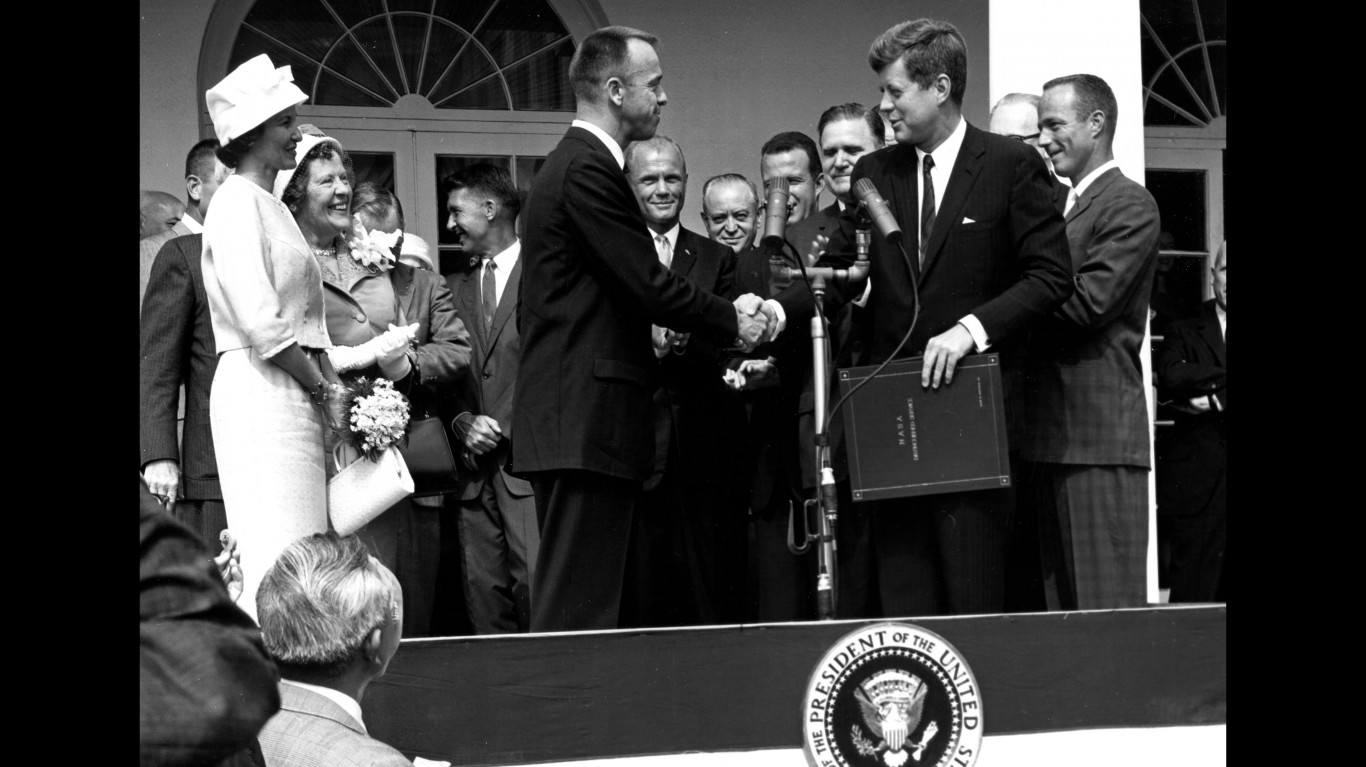
8. May 5, 1961: First American in space
America’s quest to put a man into space started with NASA’s Mercury 7, a group of select test pilots chosen from 100 volunteers. They included Alan Shepard, Jr., who would be chosen as the first American to enter space inside the Freedom 7 capsule on May 5, 1961. Lasting just over 15 minute and reaching an altitude of 116 miles, the suborbital flight came less than a month after Russia put a man into orbit. But it signaled the launch of America’s space program. The accomplishment was watched by 45 million television viewers, and Shepard received a hero’s welcome. President Kennedy honored him with a Distinguished Service Medal, and just a few weeks later announced that America would put a man on the moon by the end of the decade.
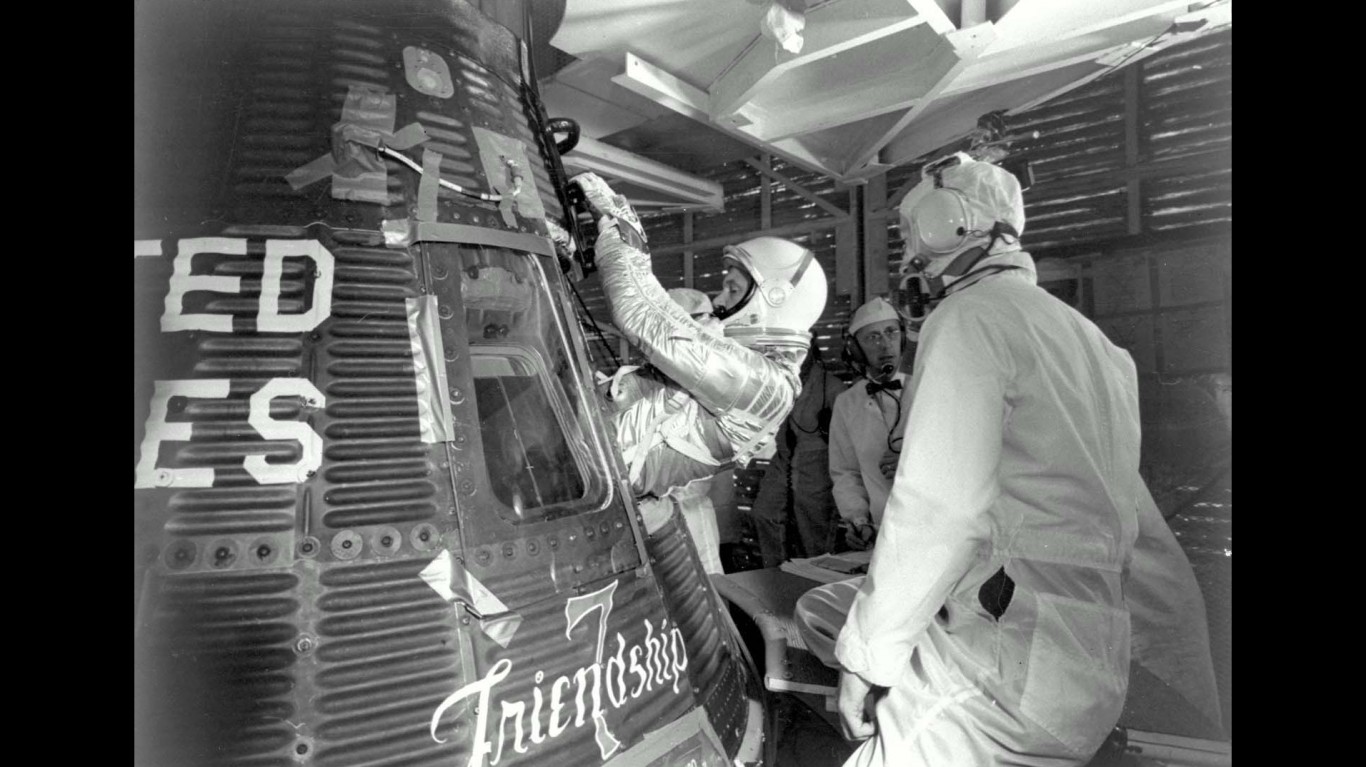
9. February 20, 1962: First American to orbit Earth
In the space race against the Soviets, the Americans had yet to beat or even keep up with their counterparts. They had managed to put a man into space just weeks after the Russians, but not into orbit like the Cosmonaut Yuri Gagarin. Part of the Mercury 7 elite group of first astronauts, John Glenn was selected as the third American in space and the first to orbit Earth, launching in the Mercury capsule Friendship 7 on February 20, 1962. The accomplishment launched America into orbital space flight, beating the Soviet Union to the moon in under a decade. It made Glenn famous; he was a U.S. senator from 1974 to 1999, and became the oldest man to fly into space at age 77.
[in-text-ad-2]
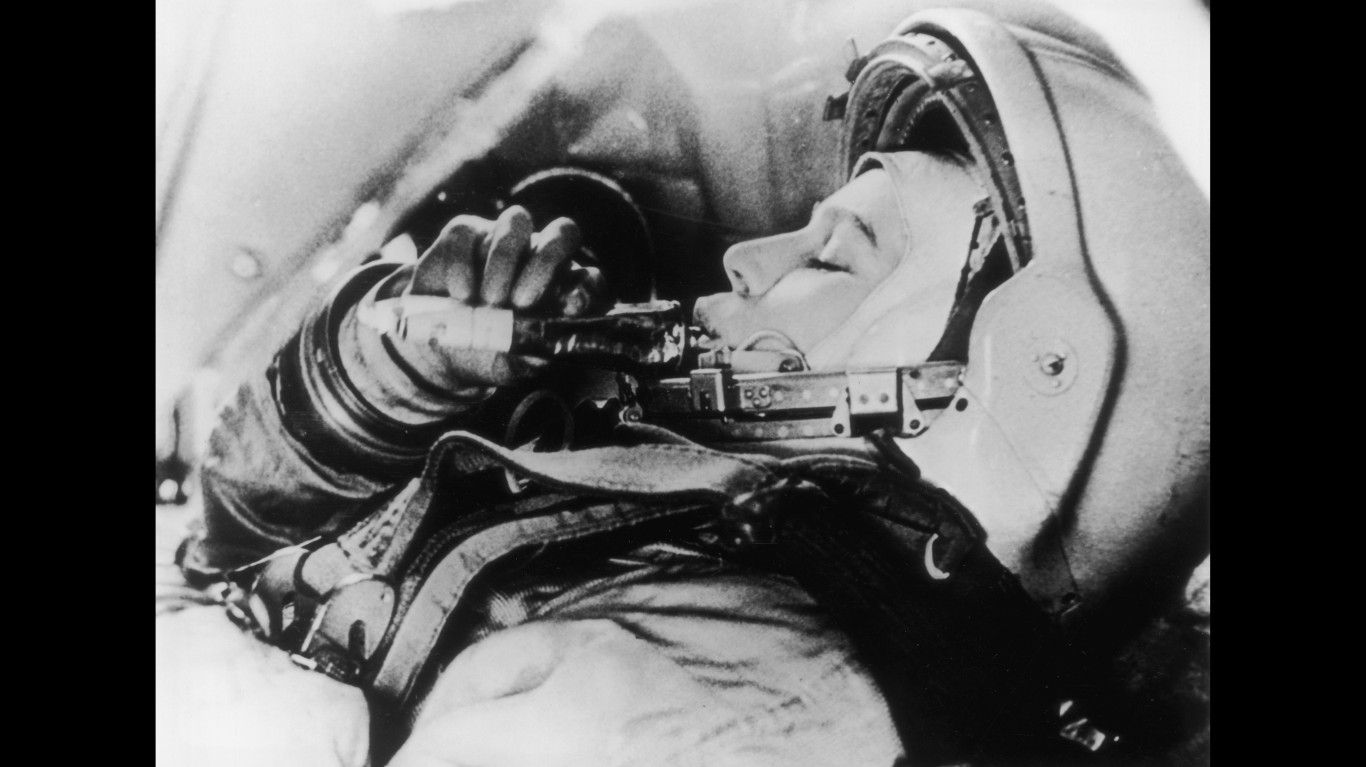
10. June 16, 1963: First woman in space
Americans may remember Sally Ride as paving the way for female astronauts, but two decades earlier, Soviet cosmonaut Valentina Tereshkova became the first woman to fly into space on June 16, 1963. She was one of four women who were trained for the journey at the time, but the only one to take flight. Vostok 6 was a dual mission with Vostok 5, piloted by cosmonaut Valeriy Bykovsky, and also made history by coming within just three miles of each other and exchanging communications. Tereshkova completed 48 orbits during her three-day mission, but her flight almost turned catastrophic when navigation caused the ship to move away from Earth. Tereshkov was honored as a Hero of the Soviet Union after her feat, and also received the Order of Lenin and the Gold Star Medal. It was decades before the Soviet Union sent another woman into space, in 1982, followed by the U.S. in 1983. Tereshkova, at age 26, remains the youngest female astronaut in history.
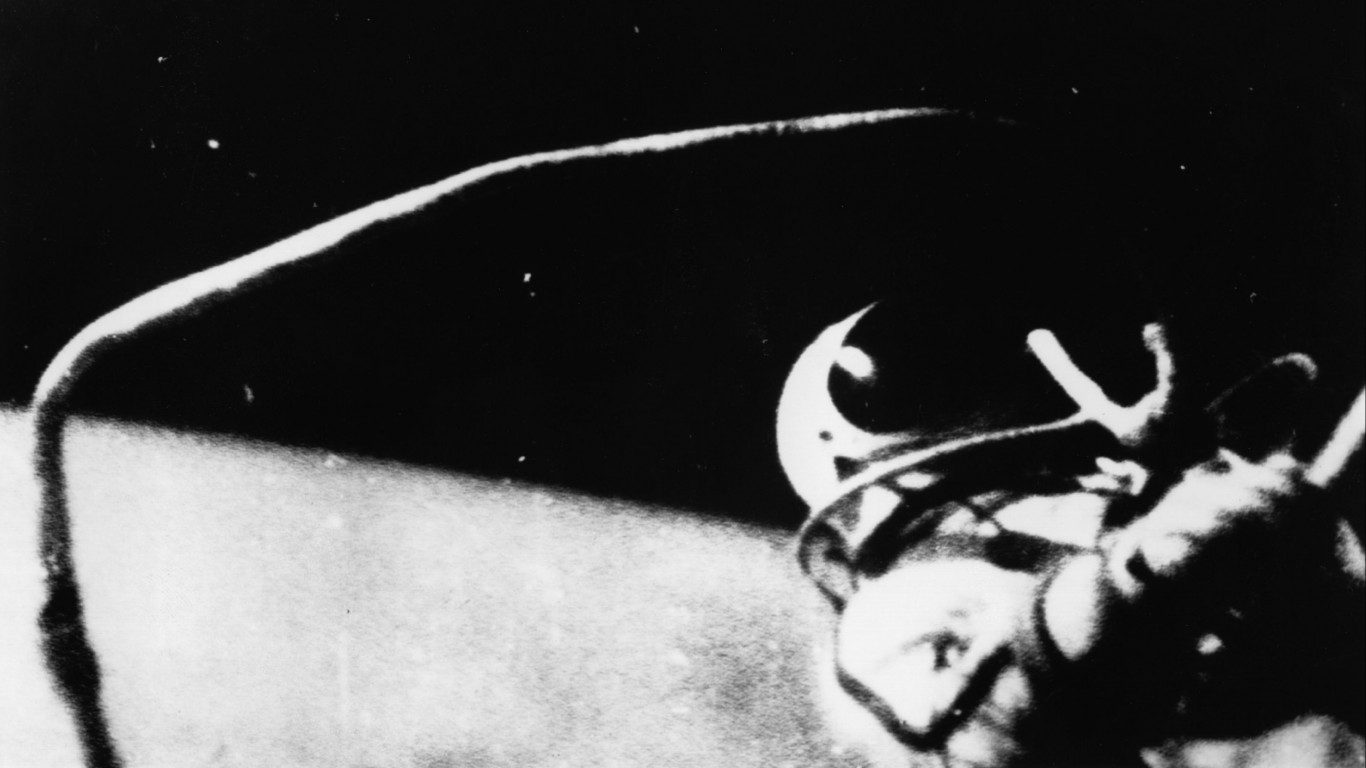
11. March 18, 1965: First spacewalk
With the first spacewalk, the Soviets once again beat America in the space race. But the rush to beat the U.S., which was mere months from the achievement itself, led to near disaster — a fact that wasn’t disclosed until years later. On March 18 1965, cosmonaut Alexei Leonov walked in space for the first time, for 10 minutes. An inflated space suit made it nearly impossible for Leonov to re-enter the spacecraft in time, however. This malfunction was followed by rising oxygen levels in the craft that nearly killed the crew and high exposure to G-forces, that caused them to land in a remote area of Siberia.
[in-text-ad]
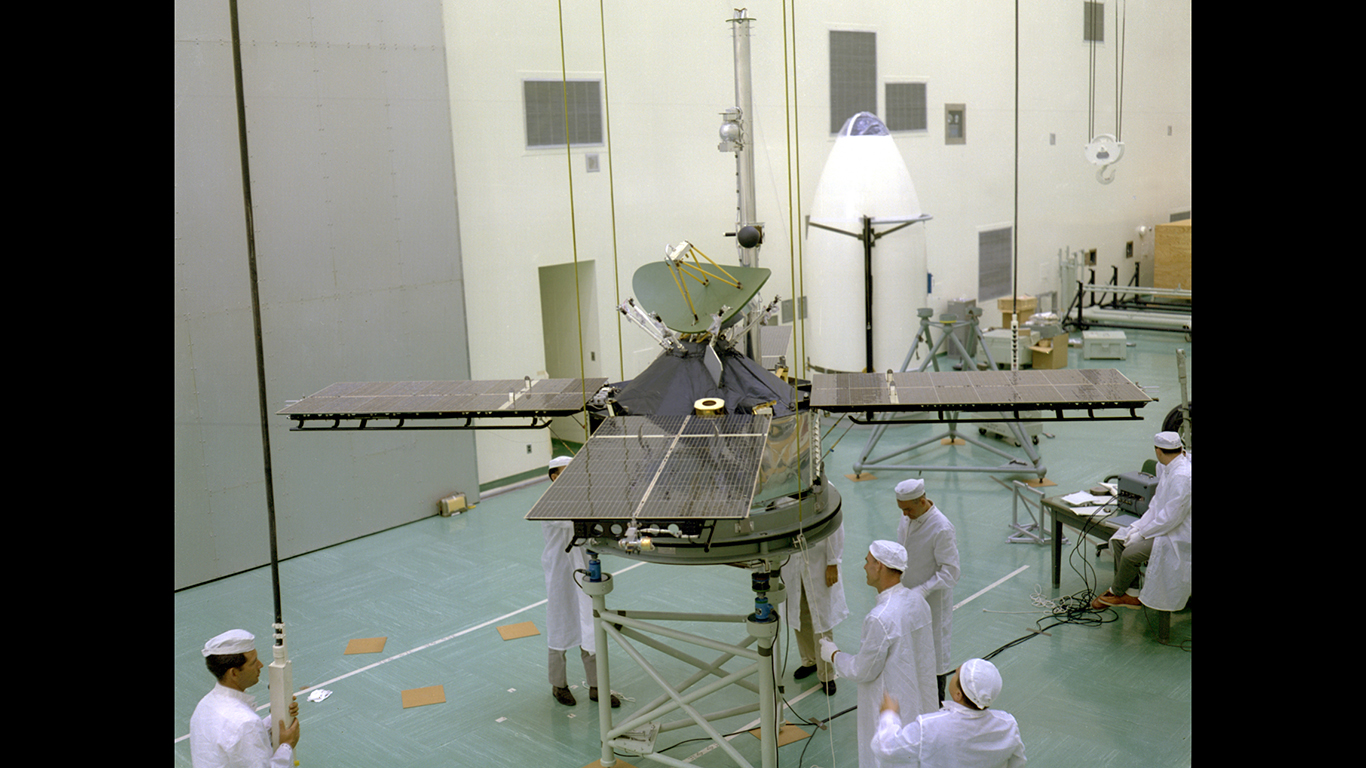
12. June 14, 1965: First pictures of Mars
The first close-up photos of the Red Planet wowed the world. Setting a record for long-distance communication, the July 15, 1965 photos from NASA’s Mariner IV mission took almost nine hours to reach Earth. A large television camera mounted on the bottom of the Mariner probe captured 21 images that would take months to be fully analyzed.
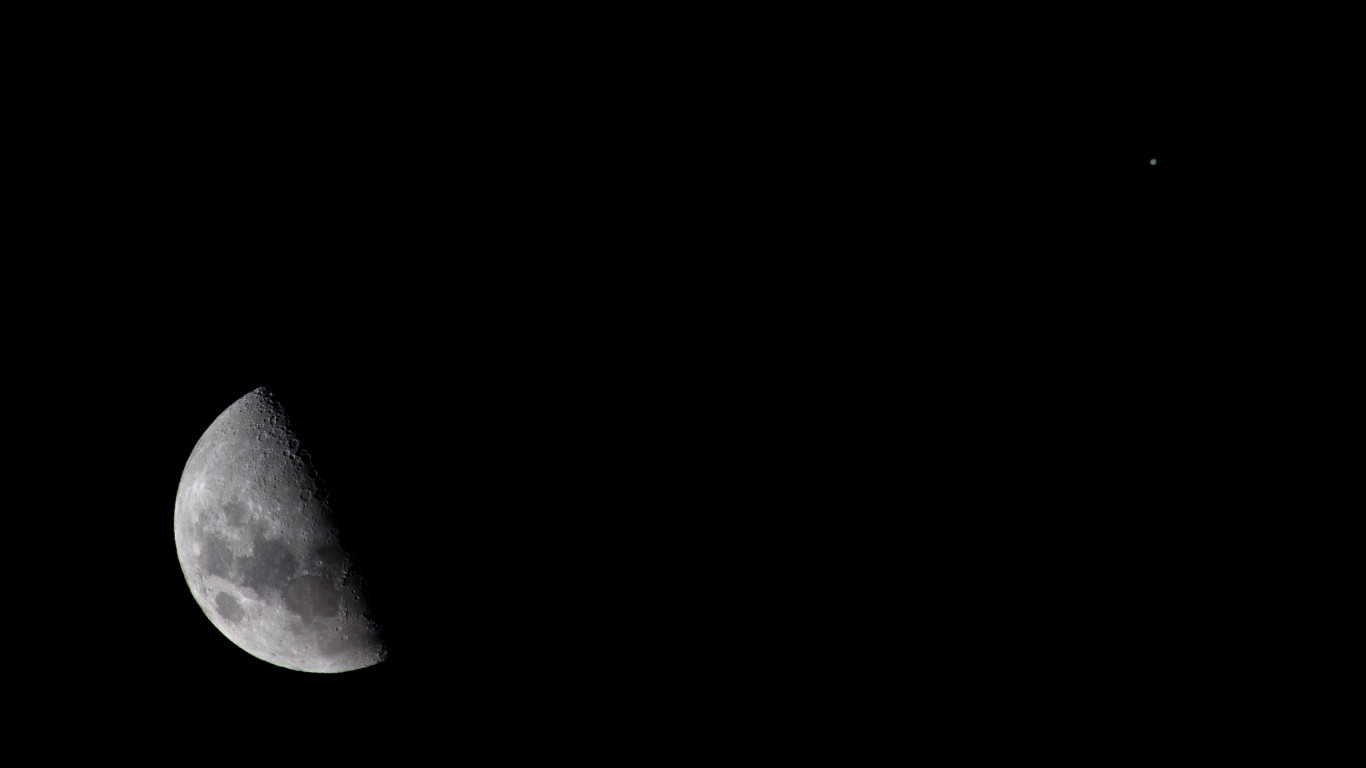
13. February 3, 1966: Landing a craft on the moon
Part of a series of unmanned probes launched by the Soviet Union, Luna 9 achieved the first lunar soft landing on February 3, 1966. The spacecraft ejected a landing capsule successfully onto the surface, which included a radiation detector and television camera to send photos back to Earth, capturing the first look at the moon’s surface. Though Luna 9 only lasted three days on the moon’s surface, more soft landings followed, including one by the United States on June 2 of the same year. Surveyor 1 was more advanced than Luna 9, and was able to send back 11,000 photos — helping the U.S. pull ahead in the race to put a man on the moon.
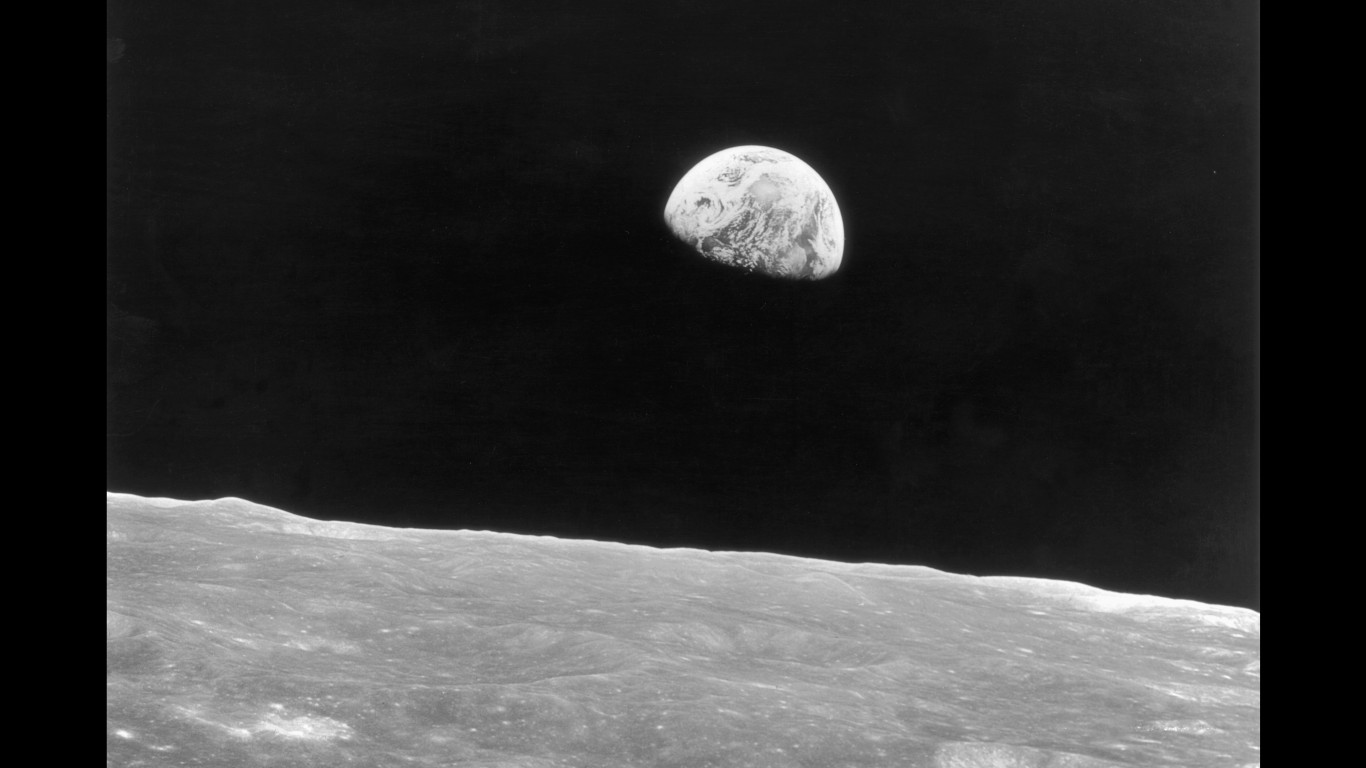
14. December 21, 1968: First orbit of the moon
Launched on December 21, 1968, NASA’s Apollo 8 mission was the first manned lunar orbit. On board the spacecraft were astronauts Frank Borman, William Anders and James Lovell, Jr. They experienced 10 revolutions around the moon before returning safely to Earth six days later. During the trip, the astronauts took the “Earthrise” picture that remains one of the most famous photos of the planet.
[in-text-ad-2]
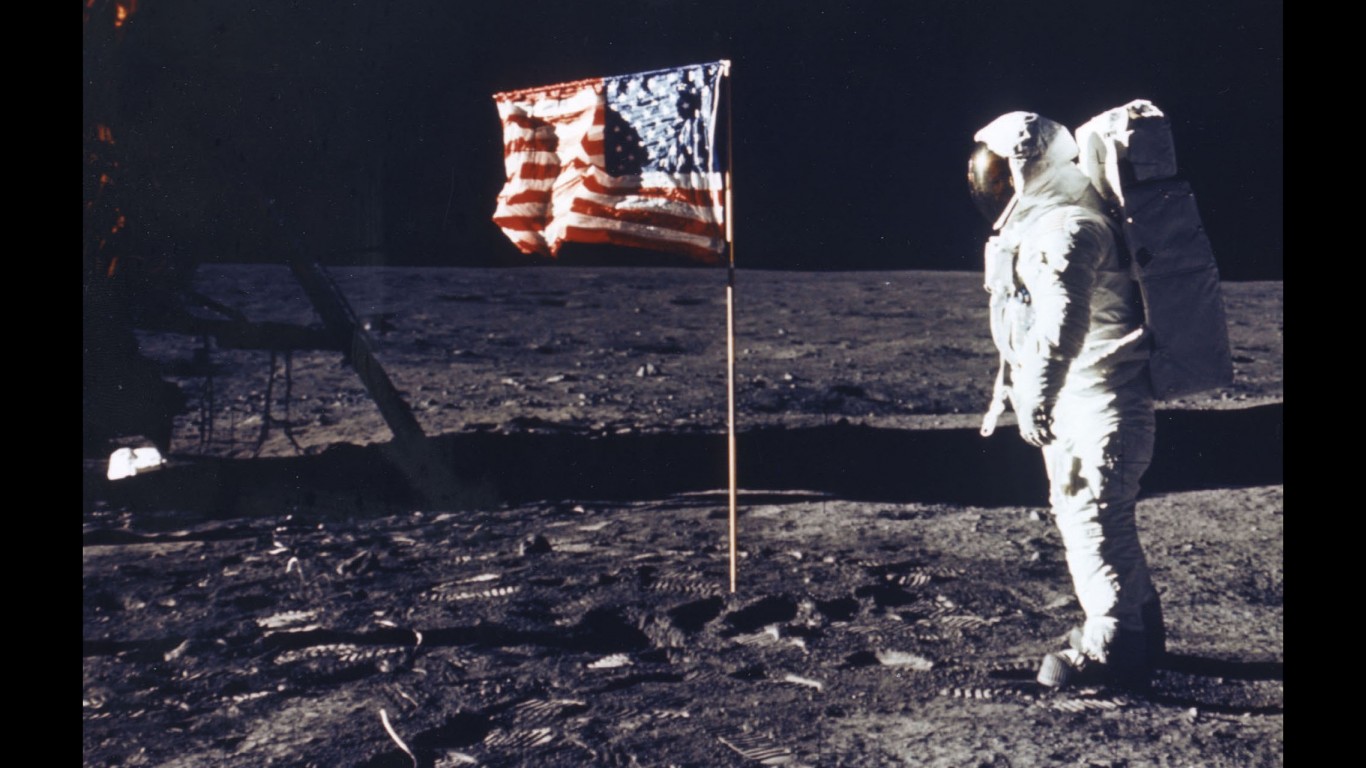
15. July 20, 1969: First man on the moon
America put a man on the moon for the first time with the Apollo 11 mission on July 20, 1969, effectively winning the space race with the Soviet Union. Neil Armstrong became the first person to walk on the moon, when he famously said: “That’s one small step for man, one giant leap for mankind.” Edwin “Buzz” Aldrin also made history as the second human to land on the moon, while Michael Collins remained in orbit around the moon, performing experiments and taking pictures. An estimated 600 million to 650 million people watched the landing around the world.
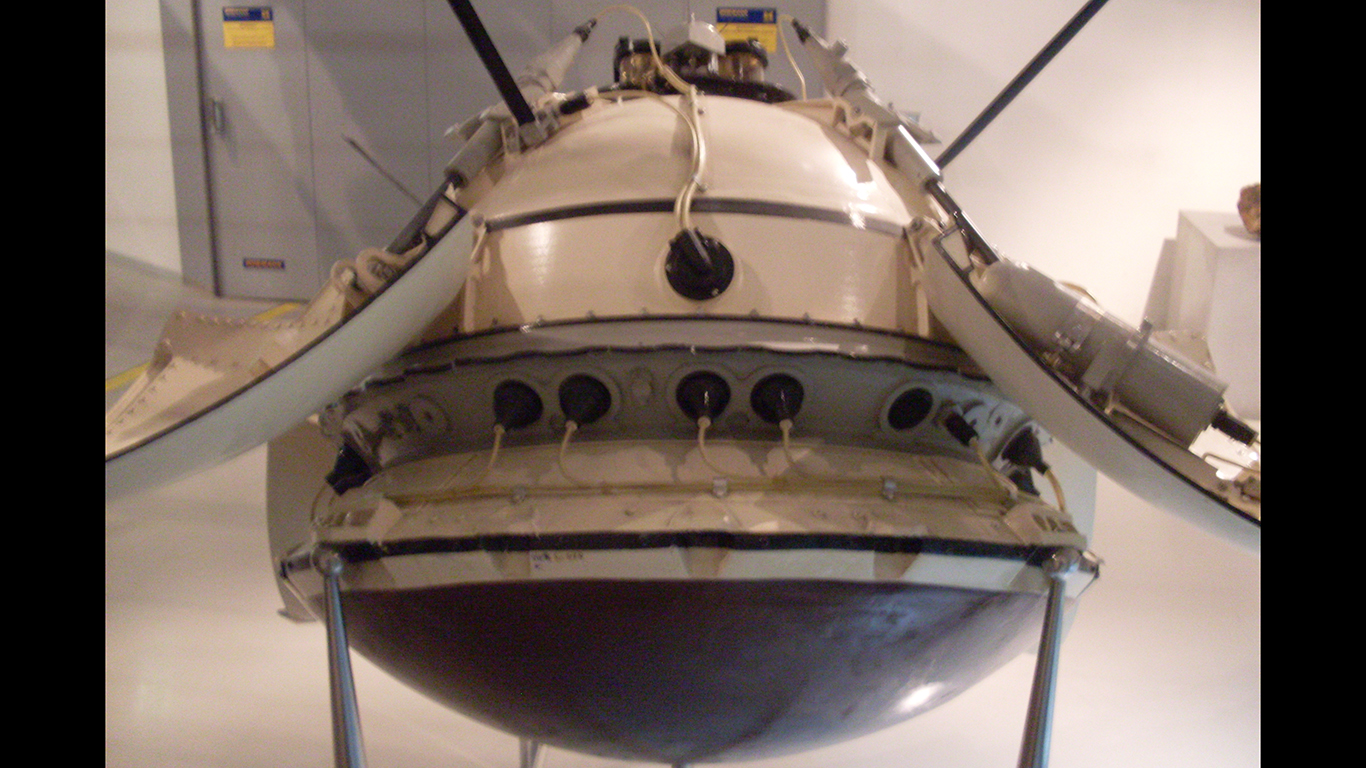
16. May 28, 1972: First soft landing on Mars
Mars 3, consisting of a satellite and landing vehicle, arrived on December 2, 1971, making the first successful soft landing on the planet. The orbiter sent data to Earth until August,1972, but the lander failed after sending only 20 seconds of video. The Soviet Union had previously tried twice to land on the planet: Mars 1’s communications failed on the way, and Mars 2 made it into orbit, but crash landed. Forty years after Mars 3 was lost, a crowdsourcing effort was made by Russian space enthusiasts to find its remains using images from NASA’s Mars Reconnaissance Orbiter (MRO).
[in-text-ad]
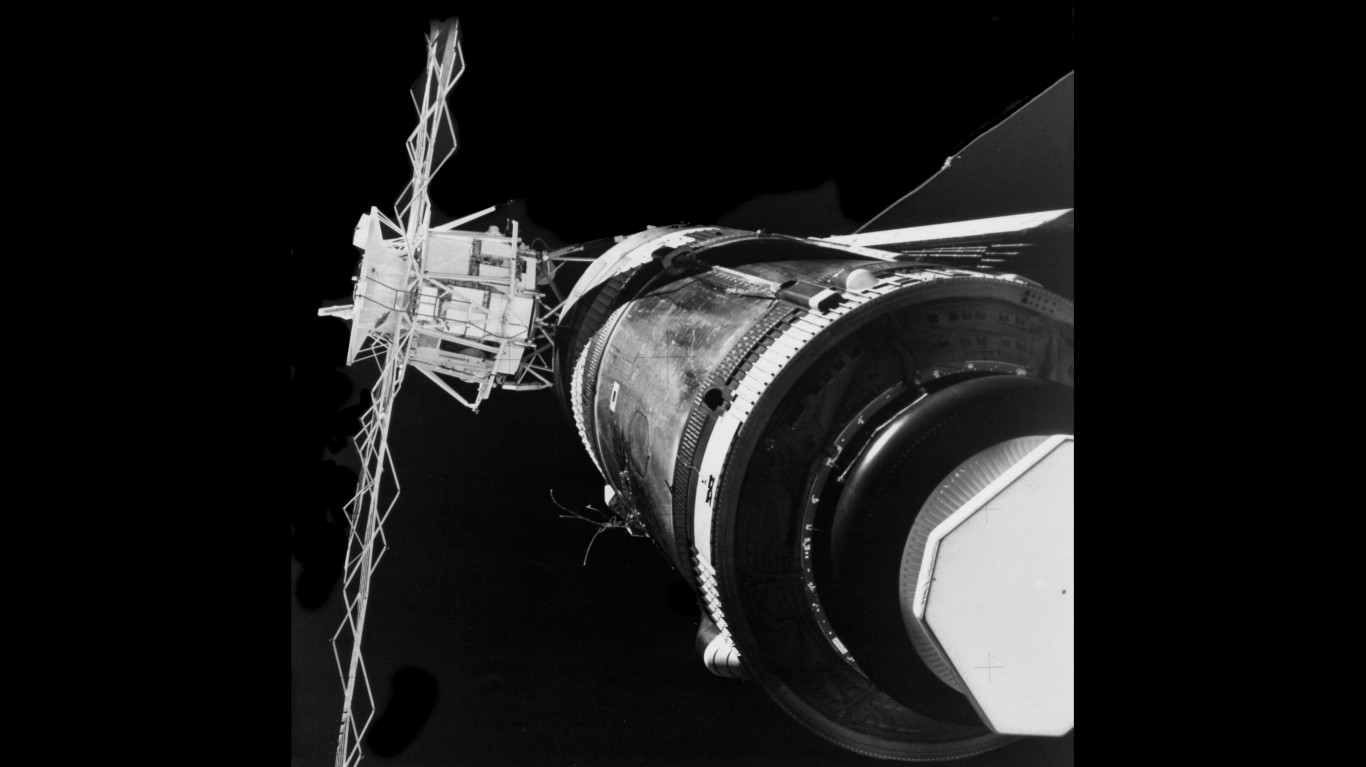
17. May 14, 1973: First orbiting laboratory
Skylab, America’s first space station, started as an idea back in 1962, finally launching on May, 14, 1973, atop a Saturn V rocket. The deployment encountered technical issues, even once it reached orbit, but NASA was able to remedy the problems. Three crews spent 28, 59, and 84 days, respectively, performing close to 300 experiments at the station. Skylab lasted for just over six years before falling out of orbit in July 1979.
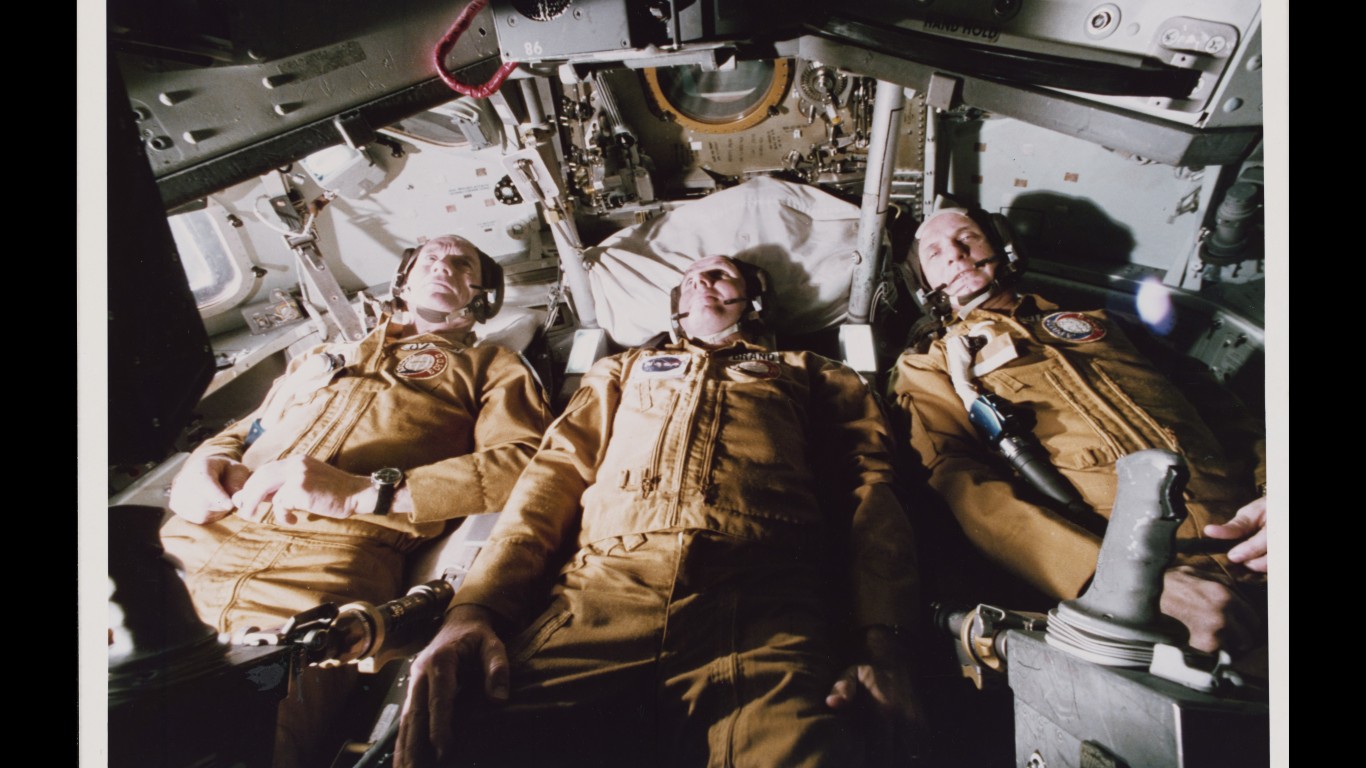
18. July 17-19, 1975: The Apollo-Soyuz Test Project
Once rivals in the space race, the U.S. and Soviet Union teamed up for the Apollo-Soyuz Test Project (ASTP), the first international human spaceflight, launched on July 15, 1975. Also known as the “Handshake in Space,” the project docked the final American Apollo spacecraft, consisting of a crew of three, with the Soviet Soyuz spacecraft’s crew of two. The ASTP tested the compatibility of rendezvous and docking systems and international space rescue. It also set up future international efforts in space, including the Shuttle-Mir Program and the International Space Station.
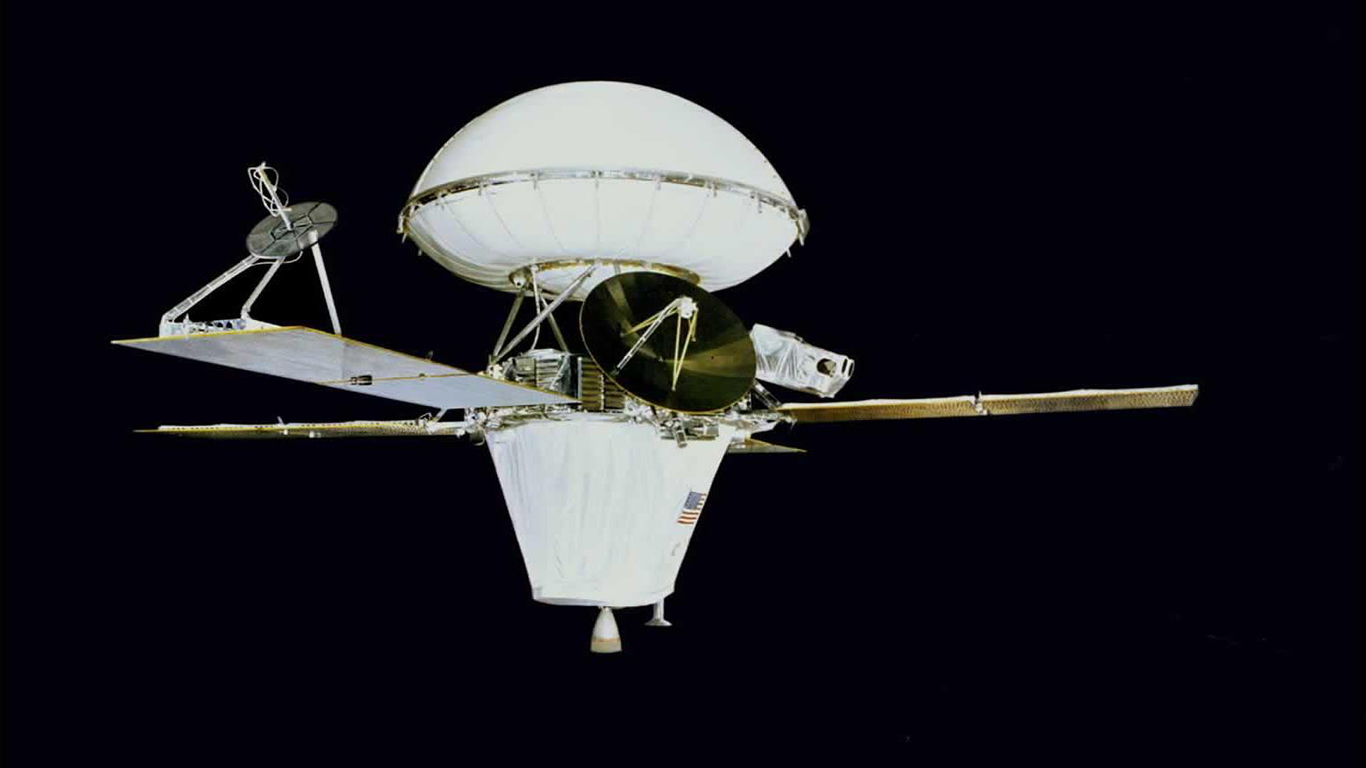
19. July 20, 1976: First successful landing on Mars
Successfully landing on July 20, 1976, Viking 1 was the first American spacecraft to touch down on Mars and the first to remain there long term. The Soviet Union’s attempts to land ended in crashes or were very short-lived. Viking 1 spent six years on the planet, providing vital information from both its orbiter and lander, including high-resolution images and experiments. The lander used its robotic arm and a biological laboratory to analyze the first Martian soil sample, characterizing Mars’ surface and atmosphere while searching for signs of life.
[in-text-ad-2]
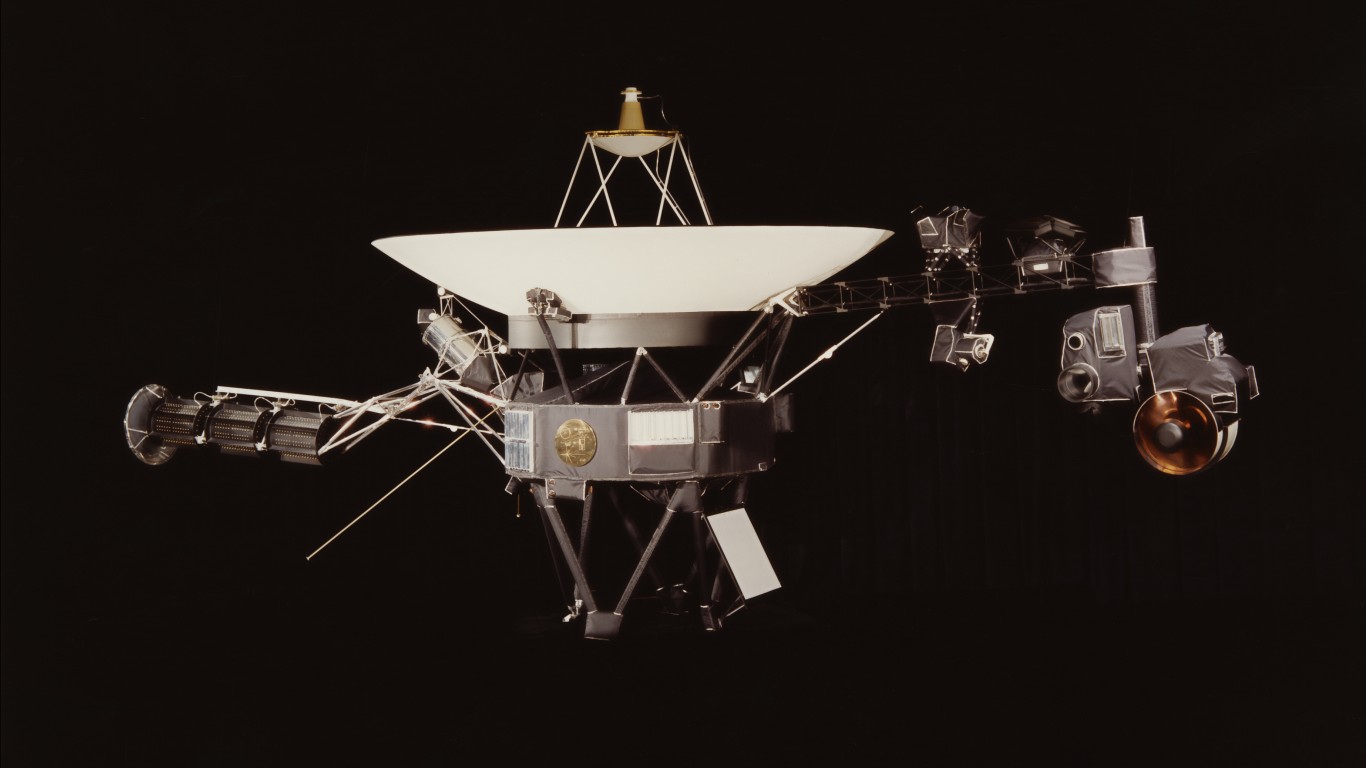
20. Starting 1977: First missions to outer planets
Voyager 1 and 2 were sent out in 1977 as the first exploration of the outer planets. The aim of both missions was to collect information on the atmospheres, interiors, satellites and magnetospheres of Jupiter and Saturn, taking thousands of photos in the process. Voyager 2’s mission was later extended to include Uranus, Neptune and beyond. The missions led to many new discoveries, including 22 satellites, Jupiter’s rings, additional information about the rings of Saturn, Uranus and Neptune, Uranian and Neptunian magnetospheres, auroral zones on Jupiter, Saturn and Neptune, and more. Though the Voyagers are no longer fully operational, NASA is still keeping track of them, and they are the only human-made objects to ever leave our solar system.
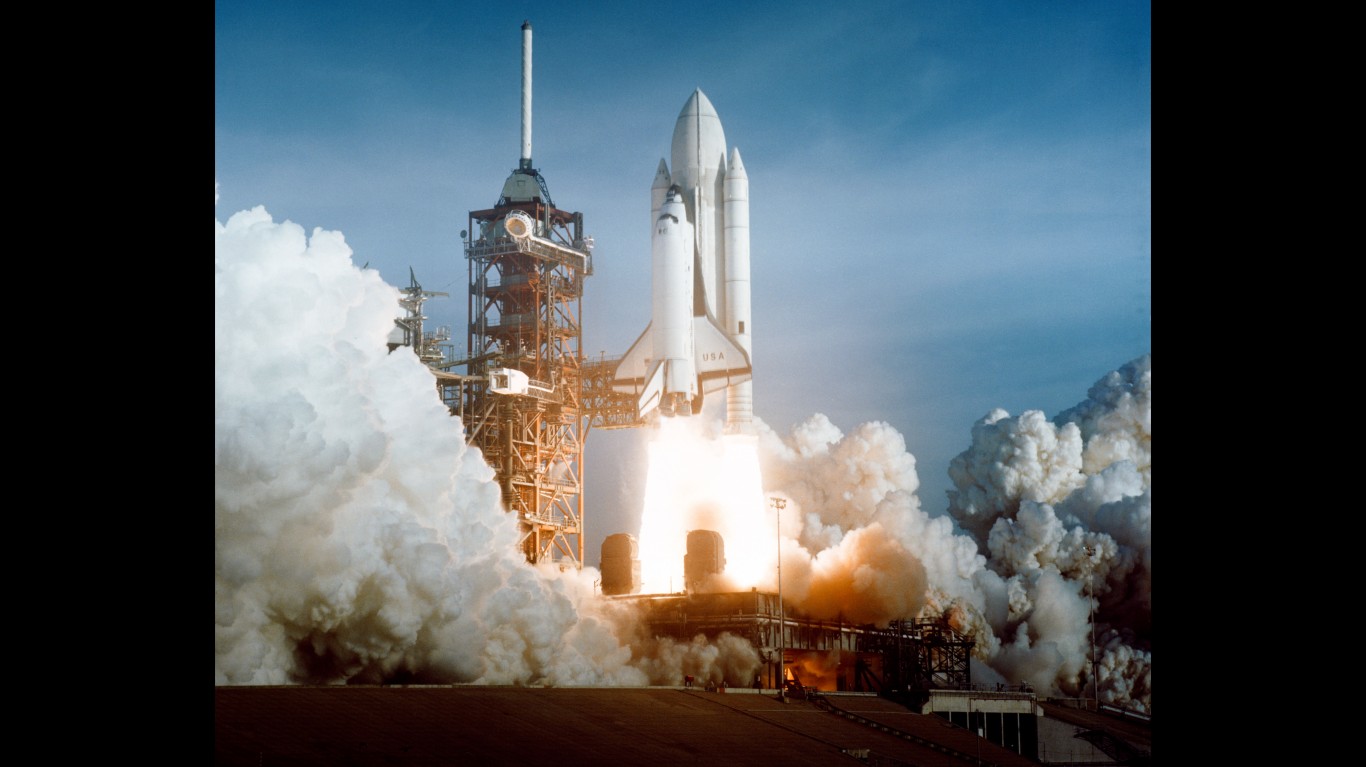
21. April 12, 1981: Space Shuttle Era
The first reusable spacecraft, the space shuttle was designed to be more like an airplane, with an aerodynamic wing shape that could touch down on a runway. It also had the advantage of being able to circle Earth at about 17,500 miles an hour. The space shuttle program launched on April 12, 1981, with the spacecraft, named Columbia, returning two days later, and continued with the shuttles Challenger, Discovery, Atlantis and Endeavour. The program inspired a whole new generation of space travel, and included the first American female astronaut and construction of the International Space Station. But it wasn’t without its challenges: the crews were lost in the 1986 Challenger and 2003 Columbia disasters. The program was able to bounce back each time, with Atlantis concluding the final space shuttle mission on July 21, 2011. The three remaining shuttles and the prototype, Enterprise, are now housed in museums.
[in-text-ad]
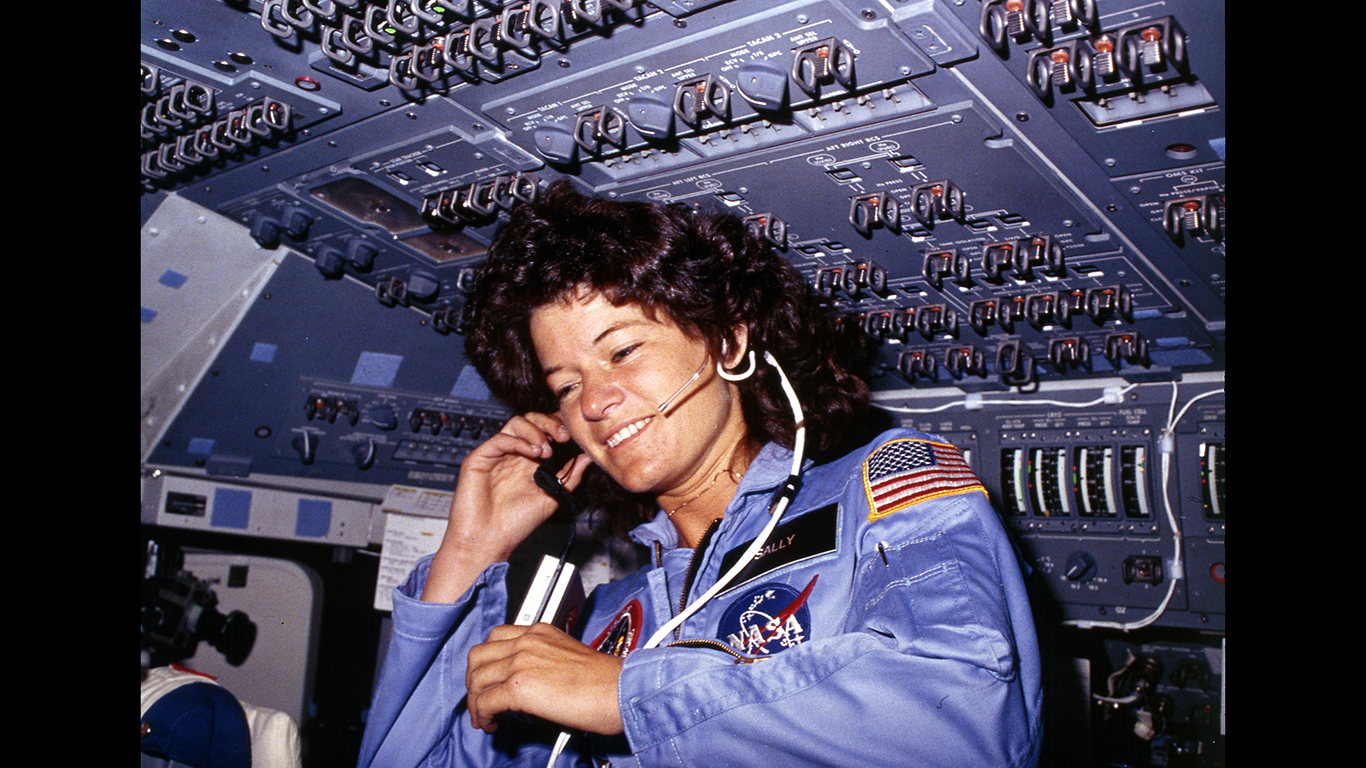
22. June 18, 1983: First U.S. woman in space
At 32 years old, Sally Ride not only became the first American woman in space but also holds the record as the youngest U.S. astronaut. Ride followed just two other female astronauts — Soviets Valentina Tereshkova in 1963 and Svetlana Savitskaya in 1982. One of only six women in NASA’s 1978 astronaut class, Ride set off on the space shuttle Challenger on June 18, 1983, During her six-day trip, she deployed satellites as a mission specialist. She flew into space again the next year, but her third mission was canceled because of the Challenger shuttle disaster in 1986. Ride worked on the investigation of that tragedy. She became director of the California Space Institute and a professor of physics at the University of California, San Diego, while working to improve STEM education, especially for girls.
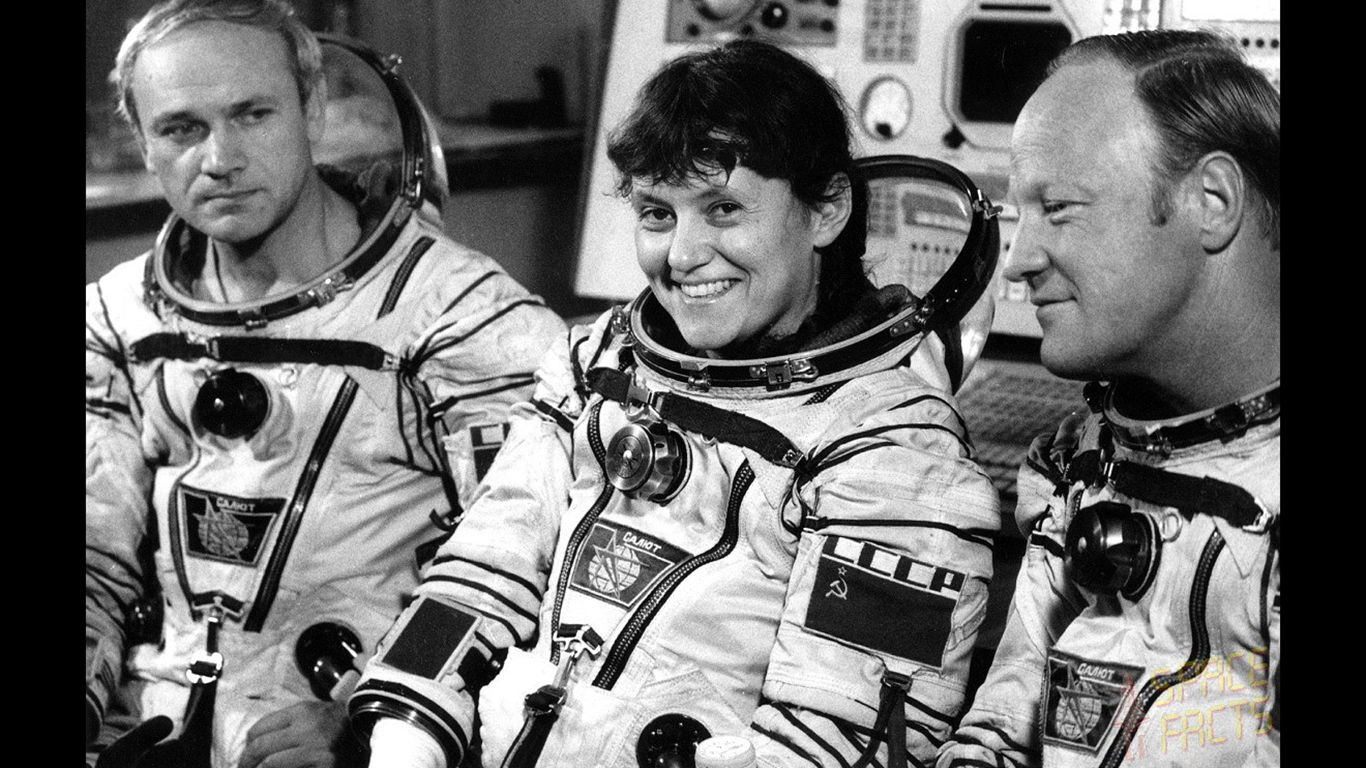
23. July 25, 1984: First woman to do a spacewalk
Svetlana Savitskaya became only the second woman in space, following Soviet trailblazer Valentina Tereshkova, when she flew the Soyuz T-7 spacecraft to dock with the Salyut 7 space station on Aug.19, 1982. But she truly made history with her second space flight on July 25, 1984. She became the first woman to walk in space when she and a fellow cosmonaut conducted welding experiments on the space station. During her mission, she also became the first woman to enter space twice.
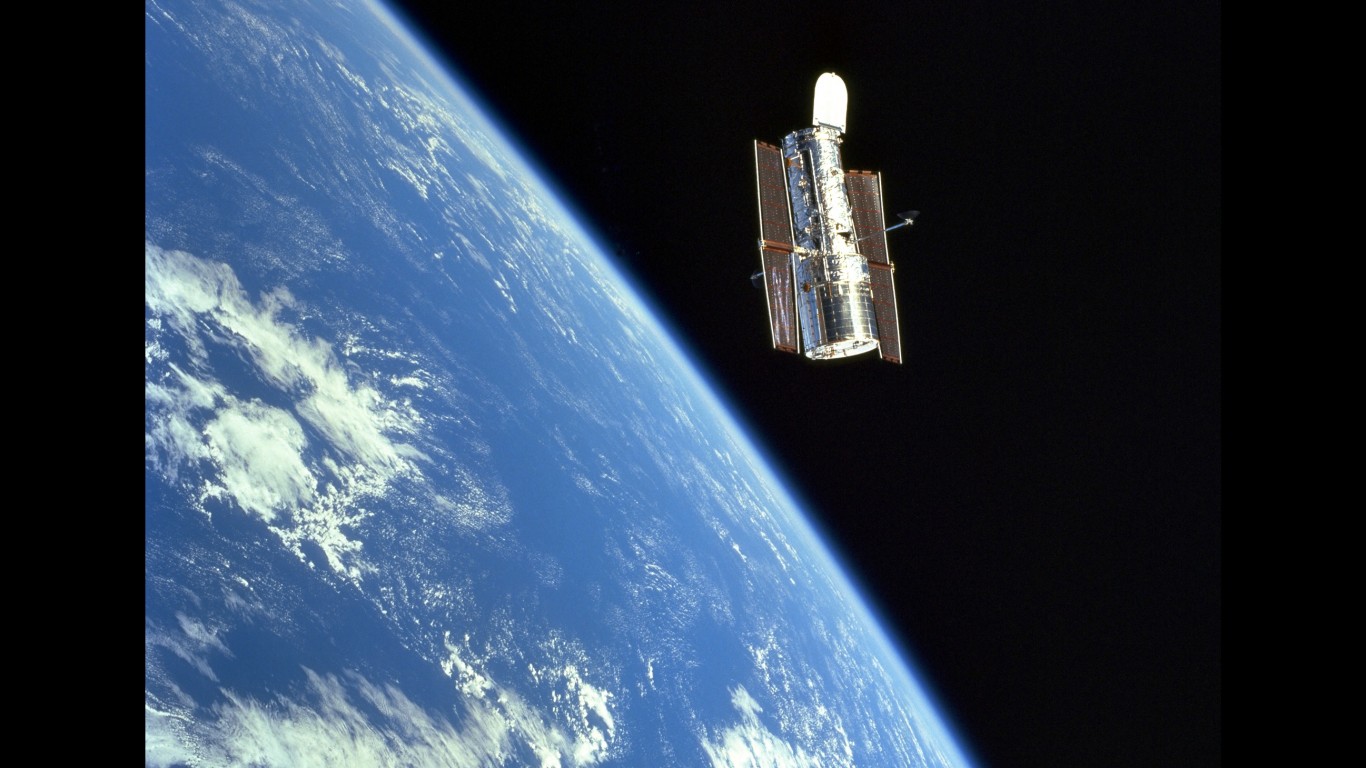
24. April 25, 1990: First space telescope to orbit Earth
Early astronomers faced a problem getting a clear view of the universe due to the distortions caused by Earth’s atmosphere. German scientist Hermann Oberth first suggested in the 1920s that this problem could be solved by launching a telescope into orbit, but this could not be achieved until space travel was possible. Still, it took even longer to develop this telescope than to reach the moon. The space shuttle program helped with the deployment of what would become the Hubble Space Telescope (HST) named after American astronomer Edwin Hubble. But the 1986 Challenger disaster delayed its launch until April 24, 1990. It took several more years until a repair mission could fix a flaw in its mirror, but the wait was worth what NASA describes as “the most significant advance in astronomy since Galileo’s telescope.”
[in-text-ad-2]
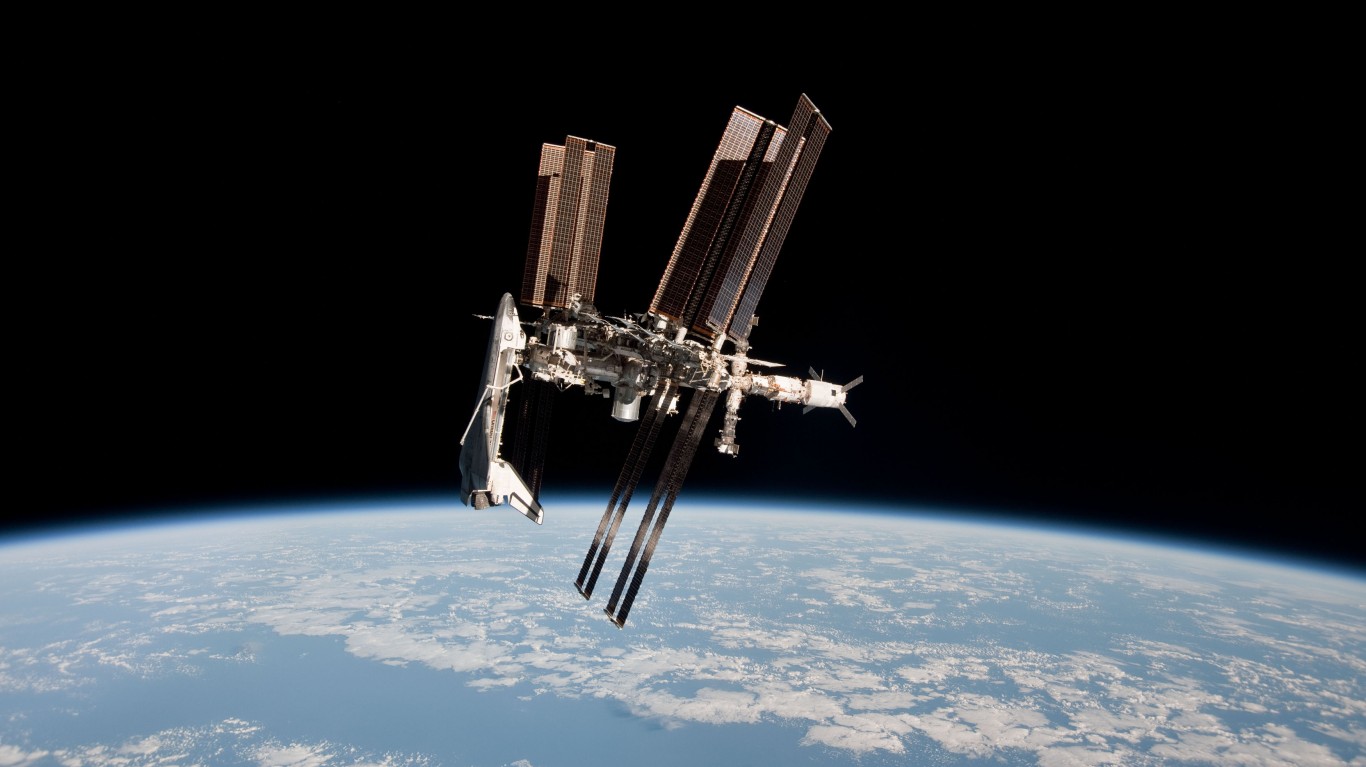
25. Started in 1998: International Space Station
A directive to NASA in President Reagan’s 1984 State of the Union Address, the building of an international space station, began in 1998 when the first segment was launched. In November 2000 the first crew was able to stay at the station, but the completion of the ISS took 10 years and more than 30 missions, with the help of five space agencies from 15 countries. It now measures 357 feet end-to-end. A total of 230 individuals from 18 countries have visited the station, and it has never been empty.
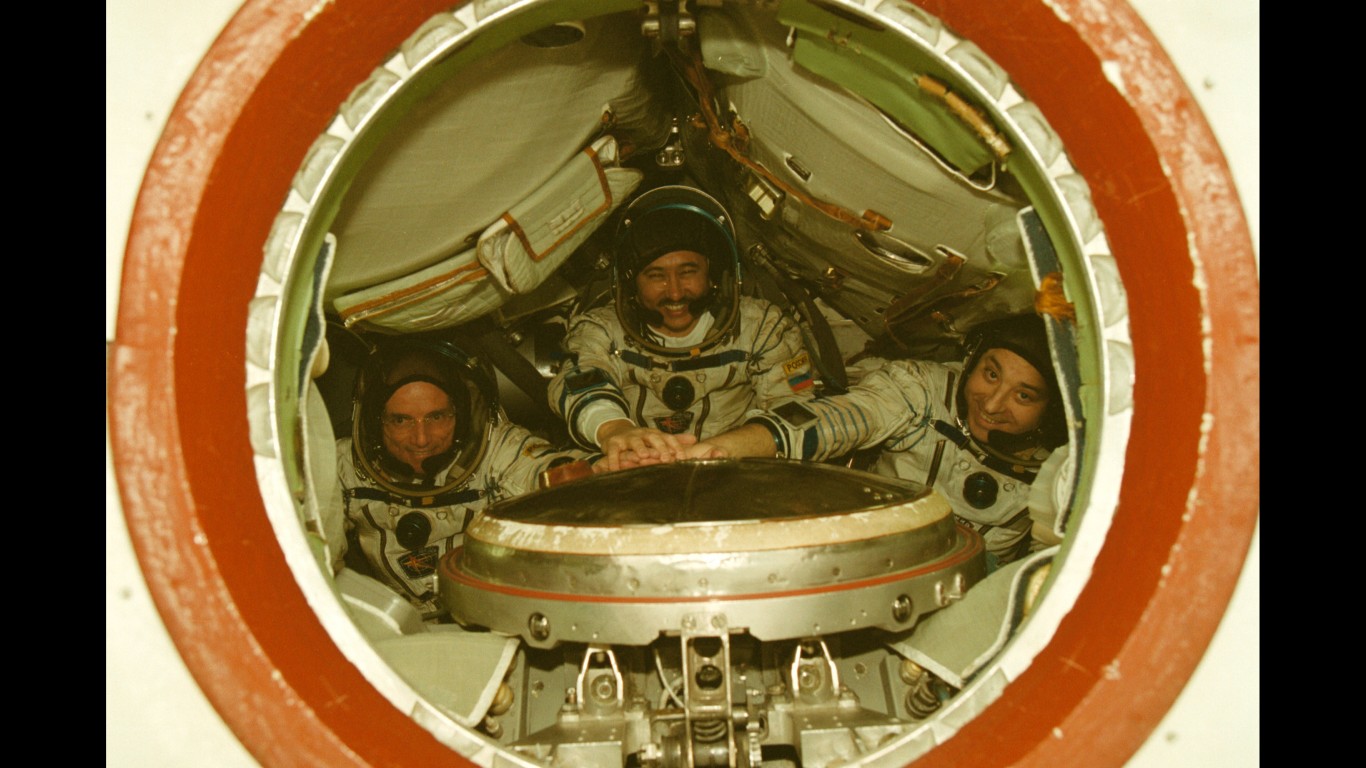
26. April 28, 2001: First space tourist
Paying $20 million and without the support of most of the international space community, American businessman Dennis Tito became the first space tourist in April 2001 aboard a Russian Soyuz spacecraft. NASA opposed his trip to the International Space Station, worried about his lack of training — not the idea of space tourism — and possibly his age — Tito was 60. “…I could see the blackness of space, I could see Earth, and the curvature of Earth, and the sight of Earth from space was just spectacular. I cannot ever duplicate that euphoric feeling that I had at that moment,” he later said of the experience. Since Tito’s flight, six other space tourists have followed, with at least two more planned for the future and more companies offering options for the trip.
Get Ready To Retire (Sponsored)
Start by taking a quick retirement quiz from SmartAsset that will match you with up to 3 financial advisors that serve your area and beyond in 5 minutes, or less.
Each advisor has been vetted by SmartAsset and is held to a fiduciary standard to act in your best interests.
Here’s how it works:
1. Answer SmartAsset advisor match quiz
2. Review your pre-screened matches at your leisure. Check out the advisors’ profiles.
3. Speak with advisors at no cost to you. Have an introductory call on the phone or introduction in person and choose whom to work with in the future
Thank you for reading! Have some feedback for us?
Contact the 24/7 Wall St. editorial team.
